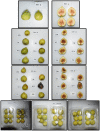A novel breathable package system to improve the fresh fig (Ficus carica L. 'Dottato') shelf life
- PMID: 35751906
- PMCID: PMC10083968
- DOI: 10.1002/jsfa.12093
A novel breathable package system to improve the fresh fig (Ficus carica L. 'Dottato') shelf life
Abstract
Background: The postharvest management of fresh figs is a susceptible phase that could impair the quality standards. Given the high perishability, their marketing is limited to around the production areas using open punnets and when marketed non-locally the use of modified-atmosphere packaging enables their quality maintenance up to 7-14 days, depending upon the cultivar, storage temperature, and packaging system. We show the results of the effectiveness of an innovative packaging system endowed with a breathable device (Blow Device®, BD) for fresh fig storage. BD was evaluated in comparison with a sealed (S) and a macro-perforated film-based tray (MF), at 2 and 8 °C.
Results: The lowest rot decay incidence was observed in S and BD (5-20% after 21 days). S significantly mitigated rot and physical-mechanical decay rate compared with BD and MF. However, S led to anoxia, with relevant carbon dioxide (CO2 ) content (30-40%), tray volume increasing, and the highest titratable acidity values. The exploitation of BD led to 10-15% oxygen (O2 ) and 5-10% CO2 , along with storage. After 14 days, the figs packed with BD had a negligible mass loss (0.2%) and excellent marketing quality parameters at both temperatures tested.
Conclusion: Exploiting an open or sealed container for extend the fresh fig' storage is not appropriate due to the severe effect of O2 or CO2 accumulation, respectively. BD enables the maintenance of high quality standards for up to 21 days at 2 °C, suggesting it could represent a profitable and sustainable solution to prevent decay after picking and reduce food losses along with wider marketability. © 2022 The Authors. Journal of The Science of Food and Agriculture published by John Wiley & Sons Ltd on behalf of Society of Chemical Industry.
Keywords: MAP; breathable film; food loss; food packaging; fresh figs.
© 2022 The Authors. Journal of The Science of Food and Agriculture published by John Wiley & Sons Ltd on behalf of Society of Chemical Industry.
Conflict of interest statement
The authors Giovanni Carlo Di Renzo, Giuseppe Altieri, and Francesco Genovese declare that they are the inventors of the patented breathable device (BlowDevice).
Figures









References
-
- Fico Bianco del Cilento. Reg. CE. N. 417 del 10.03.06 (Dossier no.: IT/PDO/0005/0282).
-
- Doster MA, Michailides TJ and Morgan DP, Aspergillus species and mycotoxins in figs from California orchards. Plant Dis 80:484–489 (1996).
-
- Doster MA and Michailides TJ, Fungal decay of first‐crop and main‐crop figs. Plant Dis 91:1657–1662 (2007). - PubMed
-
- Crisosto CH, Bremer V and Stover E, in Postharvest Biology and Technology of Tropical and Subtropical Fruits: Cocona to Mang, Vol. 3, ed. by Yahia EE. Woodhead Publishing, Cambridge, UK, pp. 134–158 (2011).
-
- Colelli G and Amodio ML, Chapter 18.5 – subtropical fruits: figs, in Controlled and Modified Atmospheres for Fresh and Fresh‐Cut Produce, ed. by Gil MI and Beaudry R. Academic Press, London, UK, pp. 427–434 (2020).
MeSH terms
Substances
LinkOut - more resources
Full Text Sources

